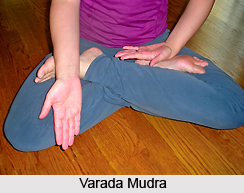 Varada Mudra also called "gesture of generosity" is the mudra of the attainment of the wish to devote oneself to human salvation. It is one of the oldest mudras and is very common amongst peaceful deities, particularly those performing the auspicious activities of pacifying and enriching.
Varada Mudra also called "gesture of generosity" is the mudra of the attainment of the wish to devote oneself to human salvation. It is one of the oldest mudras and is very common amongst peaceful deities, particularly those performing the auspicious activities of pacifying and enriching.
This mudra aptly expresses the magnificence of forgiveness, the virtue of forgiving others as well as the inner self. The Varada mudra is one of great generosity. Since, this mudra is a gesture of mercy or granting wishes, it is also referred as `Boon-Granting` mudra.
Practice of Varada Mudra
Varada mudra is easy to perform. This mudra is rarely used alone, but usually in combination with another made with the right hand, often the Abhaya mudra. This combination of Abhaya and Varada mudras is called Segan Semui-in or Yogan Semui-in in Japan.
In performance of Varada mudra, the left hand is pointed downward and the palm is turned to the front. The right hand is placed on the lap or thigh. The palm of both the hands should be completely exposed to the spectator, open and empty. The five extended fingers in this mudra symbolize generosity, morality, patience, effort and meditative concentration. In the depiction of Hindu gods , this is a preferred posture.
Benefits of Varada Mudra
•Varada mudra is beneficial to feed the mind with the virtue of forgiveness, the generousness to forgive the world.
•This mudra also helps one to control mind.
•It enables one to practice meditation with complete focus.
•It enhances one`s mental state of serenity and harmony.
•This mudra is capable of reducing anxiety and tension from an individual`s mind when it is practiced regularly.
In India, the Varada mudra can be seen in the images of Avalokitesvara from the Gupta Period of the 4th and 5th centuries. It can also be observed in the Buddha statues of Southeast Asia. These kinds of mudras are also used by monks in their spiritual exercises of ritual meditation and concentration, and are believed to generate forces that invoke the deity. Indian classical dances too involve this mudra in the dance for portrayal of varied expressions like generosity, forgiveness, kindness etc.




















